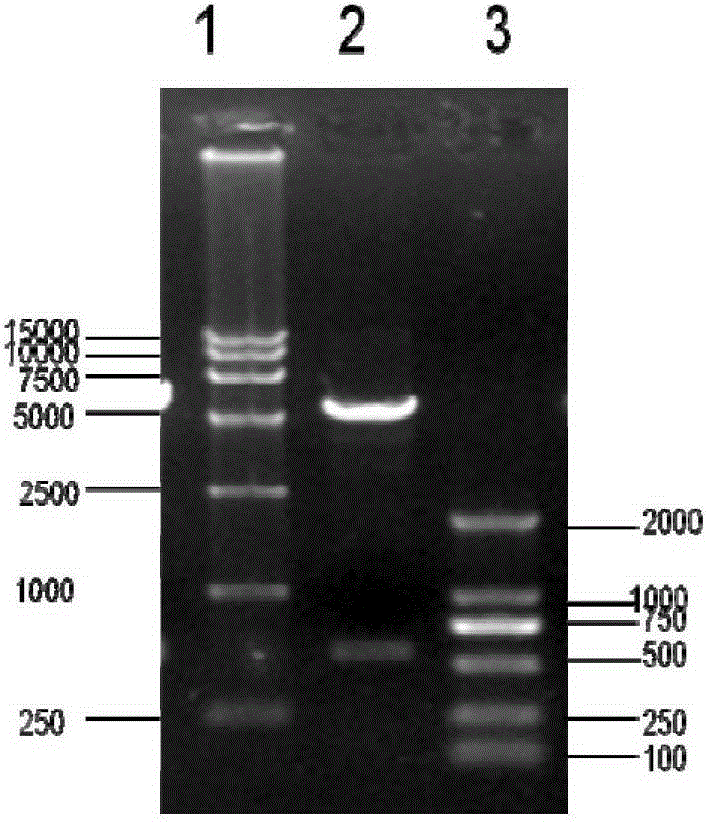Artificially synthesized polyepitope gene of porcine reproductive and respiratory syndrome virus and its application
A technique for respiratory syndrome and artificial synthesis, applied in application, gene therapy, antiviral agent, etc.
- Summary
- Abstract
- Description
- Claims
- Application Information
AI Technical Summary
Problems solved by technology
Method used
Image
Examples
Embodiment 1
[0043] Embodiment 1 Design and artificial synthesis of highly pathogenic PRRSV antigen multi-epitope gene
[0044]The present invention is based on the highly pathogenic porcine reproductive and respiratory syndrome virus WUH3 strain (its nucleotide sequence comes from GenBank: HM853673.2, see literature: LiB, XiaoS, WangY, XuS, JiangY, ChenH, etal. .2009; 27(13):1957-1963) analysis of known epitopes, select B cell epitopes and T cell epitopes related to immune protection, connect each epitope gene in series with linker, and construct PRRSV antigen multi-epitope gene (mMEP). The selected epitopes include: the T1 cell epitope of GP3 (its amino acid sequence: LEPGKSFW, see the amino acid sequence described in SEQ ID NO: 3 in the sequence listing), the T2 cell epitope (its amino acid sequence: CRIGHDRCSEN, see the sequence listing SEQ ID NO: 4) The amino acid sequence described above); the T1 cell epitope of GP4 (its amino acid sequence: CLFAILLAI, see the amino acid sequence de...
Embodiment 2
[0046] Embodiment 2 Construction of pcDNA3.1-mMEP recombinant plasmid
[0047] The construction, preparation, and enzyme digestion analysis of the plasmid were all carried out according to conventional methods (see: J. Sambrook, EF Fritsch, T Maniartis, translated by Huang Peitang, Wang Jiaxi, etc., Molecular Cloning Experiment Guide (Third Edition) ), Science Press, 2002 edition).
[0048] The specific construction steps are: after the original vector pGH-mMEP containing the highly pathogenic PRRSV antigen multi-epitope gene mMEP in Example 1 is digested with BamHI+NotI (see the enzyme digestion diagram figure 2 ), purify and recover a digested product of about 560bp, and combine it with the pcDNA3.1(+) eukaryotic expression plasmid digested with BamHI+NotI (see figure 2 ) connection, transformed Escherichia coli DH5α competent cells, extracted a small amount of plasmid (using the kit produced by Tiangen Biochemical Technology (Beijing) Co., Ltd., and operated according to...
Embodiment 3
[0050] Example 3 Large-scale preparation of plasmid DNA vaccine pcDNA3.1-mMEP and empty vector plasmid pcDNA3.1(+)
[0051] Use the large amount of plasmid extraction kit produced by Omega (operate according to the instructions in the kit) to carry out a large amount of plasmid (vaccine) extraction, the specific operation steps are as follows:
[0052] (1) Escherichia coli DH5α of the recombinant plasmid pcDNA3.1-mMEP or the empty vector plasmid pcDNA3.1(+) (purchased from Yingwei Jieji (Shanghai) Trading Co., Ltd.) were inoculated in 100 mL of ampicillin-resistant LB In liquid culture medium (the concentration of ampicillin is 100U / mL), culture with shaking overnight (12-16h);
[0053] (2) Transfer the Escherichia coli bacterial liquid obtained in step (1) to two 50mL centrifuge tubes, centrifuge at 12000r / min for 2min, discard the supernatant, and collect the bacterium precipitate;
[0054] (3) After resuspending the pellet with 2.5mL Solution I (included in the above kit),...
PUM
 Login to View More
Login to View More Abstract
Description
Claims
Application Information
 Login to View More
Login to View More - R&D
- Intellectual Property
- Life Sciences
- Materials
- Tech Scout
- Unparalleled Data Quality
- Higher Quality Content
- 60% Fewer Hallucinations
Browse by: Latest US Patents, China's latest patents, Technical Efficacy Thesaurus, Application Domain, Technology Topic, Popular Technical Reports.
© 2025 PatSnap. All rights reserved.Legal|Privacy policy|Modern Slavery Act Transparency Statement|Sitemap|About US| Contact US: help@patsnap.com



